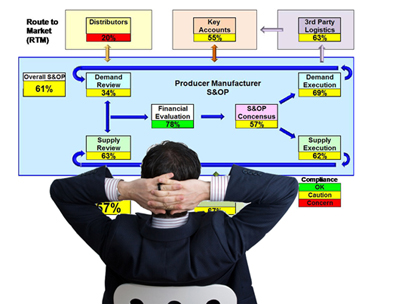I have had several discussions in response to my last blog on the subject of supply chain and S&OP compliance.
A common theme was the practicalities of measuring compliance. So here are 5 steps to make it happen.
- Supply Chain & S&OP Operating Model. Start with the blueprint or template of how the supply chain should operate. This is often a process map at several levels of detail, sometimes to procedural level.
- Checklist. Use the operating model to define a checklist of activities that should be undertaken on a regular basis; monthly is usually sufficient. Subdivide the list into key activities – e.g. Demand Review, Supply Review, Financial Evaluation, Consensus, Demand Execution, Supply Execution. Clearly define for each activity what constitutes compliance.
- Process Owners. Assign a process owner to each key activity. These people nearly always pick themselves as depicted by their operational roles. Their roles should now include formal responsibility for reporting compliance each month.
- Measuring Compliance. A reporting mechanism is now needed. We have found that some type of tool is the best way of capturing compliance data and information. The tool should be accessible by process owners of course and be visible to the operational management team and team of senior executives. Tools can be spreadsheet based (this is often a good place to start), web based or utilise social networking tools. The key issue is to make the tool easy to use and accessible. We would also advise that the tools focus not only on compliance as such but also on improvement. As such it is a good idea to include a section in the tool related to a short narrative on status and future improvement actions. Brief and train users in the use of the tool and, critically, on why it is being deployed. If possible aim for a ‘sell approach’ but a ‘hard sell’ – this is a critical part of company operations.
- Keep it Simple. People do not like what they perceive as extra work. People also do not like filling out forms, even if they are within well designed tools. Whatever type of tool or reporting mechanism you choose, test it and time how long it takes to complete. If it is longer than 10 minutes (maximum 15 minutes), it is too complicated.

You are now ready to go.
Our experience is that if you stick to these 5 steps, you will have a practical approach to ensuring the extent to which your supply chain and S&OP operating model has been successfully deployed.
If you would like more help with checking supply chain and S&OP compliance, please do contact us – we have done this successfully many, many times before.

Read other posts regarding Compliance HERE.







